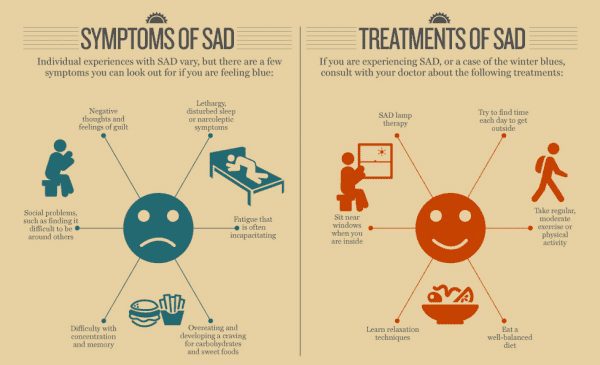
A few weeks ago, the clocks were set back an hour, giving us shorter days and longer nights as we approach the winter solstice in December. This transition can sometimes wreak havoc on our circadian rhythm, causing us to perhaps wake up earlier than normal as the sun rises or feel sleepier sooner. This time change, and adjustment to longer nights, can also affect our mood, productivity, and behavior.
There is a subset of depression called seasonal affective disorder (SAD), which is defined as a seasonal cycle of depression that often manifests during the winter months. Typically, the symptoms of SAD are similar to those of major depression but only occur during the fall and winter seasons. Here are some examples of symptoms:
- Losing interest in activities you once enjoyed
- Overeating, weight gain
- Social withdrawal
- Sleeping too much
- Persistent fatigue
- Difficulty concentrating
Millions of adults suffer from Seasonal Affective Disorder and may be unaware they have the condition. It is more common in women and typically affects those who live farther north. There is also evidence to support that SAD runs in families and is more common in those with a previously diagnosed mental illness.
It is believed that SAD is caused by reduced activity of serotonin, a chemical in the brain that is responsible for mood regulation. Sunlight plays a role in the regulation of serotonin levels in the brain, which explains why Seasonal Affective Disorder is often present in the winter months.
In addition, people with SAD often have excessive amounts of melatonin, which is another brain chemical that is responsible for maintaining a normal sleep/wake cycle. With too much melatonin, we can feel sleepy and fatigued throughout the day. These alterations in brain chemicals contribute to SAD and also disrupt our daily rhythm.
If you believe that you meet the criteria for SAD, you should speak to a mental health provider about specific recommendations and treatments. Outlined below are three ways to combat the winter blues that are relevant to anyone who feels less productive, less happy, and/or more tired in the winter months.

Light therapy and Seasonal Affective Disorder
The gold standard treatment for Seasonal Affective Disorder is light therapy which consists of using a light box or lamp that emits bright light to mimic sunshine. Typically, people turn the lamp on in the morning, within the first hour of waking up, and spend up to an hour sitting in front of the light. Most lamps filter out any potentially damaging UV light, which makes this a safe treatment with minimal risks.
The goal of the treatment is for the bright light to elicit the same affects in the brain that natural sunshine would. In the case of SAD, we are aiming for improvement in serotonin levels. Here is a link to a list of the top light therapy boxes: https://www.health.com/depression/best-light-therapy-boxes
Vitamin D and Seasonal Affective Disorder
Vitamin D plays a role in many essential biological processes, including calcium absorption, bone growth, reducing inflammation, and promoting serotonin activity. As we have evolved to spend a significant portion of our time indoors, vitamin D deficiency has become more common; in fact, it is estimated that 13% of the population is deficient in this essential vitamin. Vitamin D is synthesized in the skin due to exposure to sunshine, it is also found in certain foods such as salmon, tuna, mushrooms and eggs.
Studies around vitamin D supplementation and depression, not just SAD, have produced mixed results. Some studies have showed that increasing vitamin D levels helped improve the symptoms of depression while other studies showed no difference between vitamin D supplementation and a placebo. The link between vitamin D and depression is not completely understood, but it stems to reason that in the winter months our already low levels of vitamin D plummet due to less sunshine exposure. Adding more foods rich in vitamin D to your diet or taking a vitamin D supplement are good ways to keep the level of this nutrient in a healthy range.
Physical Activity and Seasonal Affective Disorder
It is generally well known that exercise can produce endorphins, a type of chemical in the brain that makes us feel energized, happy, and in less pain. The good news is that exercise not only produces endorphins, it also has been proven to release dopamine, norepinephrine, and serotonin. These brain chemicals all play an important role in regulating mood and energy.
Getting regular amounts of exercise has been shown to positively affect symptoms of depression, and research is ongoing as to how physical activity affects SAD specifically. What we know for certain is that Seasonal Affective Disorder is affected, at least in part, by decreased levels of serotonin and that exercise has been shown to improve these levels. If you start feeling blue around the fall and winter months, you may feel less motivated to exercise and more motivated to go to sleep early or lay on the couch. Instead, try incorporating small amounts of activity into your day, consisting of something you enjoy doing, like going on short walks or bike rides to boost your energy and improve your mood.
Catherine Madsen, PT, DPT https://charmaustin.com/why-charm/the-charm-team/catherine-madsen/
Sources:
https://www.nimh.nih.gov/health/publications/seasonal-affective-disorder/index.shtml
https://ods.od.nih.gov/factsheets/VitaminD-HealthProfessional/
https://www.ncbi.nlm.nih.gov/pmc/articles/PMC2908269/
https://www.healthline.com/health/depression/exercise#Exercise-and-brain-chemistry




